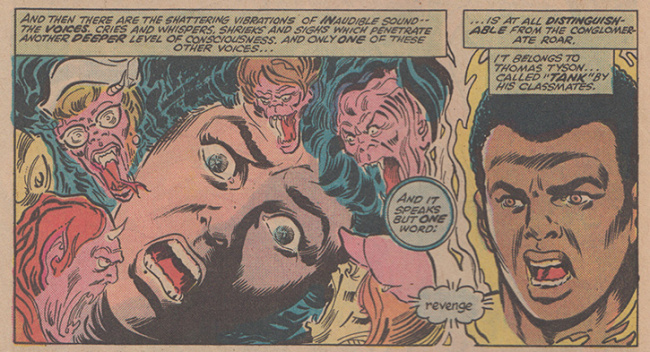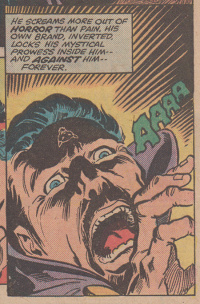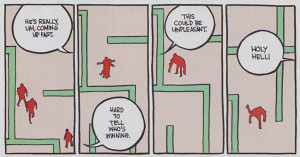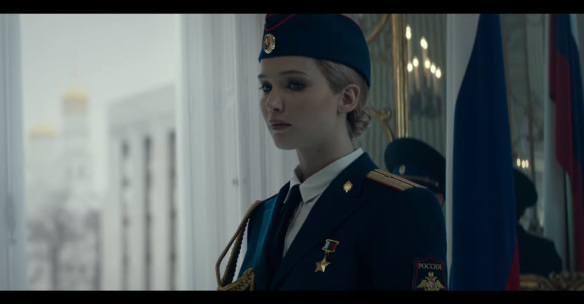Welcome to Alpha & Omega! The blog series where we take a look at one issue each of the two Omega the Unknown comic book series—the original from 1976-77 and the re-imagining from 2007-08. The original plan was to do a pair of issues a month for 11 months, but sometimes other obligations come first, so we’ve skipped a month here or there, but we’re committed to getting through the entirety of both series, plus the two issues of Defenders where the original series was wrapped up.
Omega the Unknown volume 1, #5
Cover Date: November 1976
Release Date: August 17, 1976
Writers: Steve Gerber and Mary Skrenes
Penciler: Jim Mooney
Inker: Jim Mooney
Colorist: Jan Cohen
Letterer: Joe Rosen
Omega the Unknown volume 2, #5
Cover Date: April 2008
Release Date: February 8, 2008
Writers: Jonathan Lethem w/ Karl Rusnak
Penciler: Farel Dalrymple
Inker: Farel Dalrymple
Colorist: Paul Hornschemeier
Letterer: Farel Dalrymple
The Covers
Both of these covers are fantastic. The 1976 Omega the Unknown, by Gil Kane, moves in a different direction from the series’ previous covers. Instead of a scene and word balloons, it centers the figure of Omega racing towards the viewer, power emanating all around him. It is the kind of cover I could imagine working for a contemporary comic. The cover for volume 2’s issue is quiet, where the original’s is bombastic. We see Alex laying out an Omega the Unknown costume, a look of fear and anxiety on his face. There is a strong visual tension between his adolescent body and the tall masculine figure meant to fill out the uniform.

James-Michael Starling hears voices manifesting in the demonic faces of those around him (OtU vol.1, #5)
The Issues
Omega the Unknown volume 1, #5 opens on a moment of violent recognition. John Nedley—whose equivalent character, Hugh, over in volume two is in the hospital for a self-inflicted gunshot wound—stumbles into the cafeteria for help. Beaten up by Nick and his thuggish crew, John ends up in the hospital. He has lost an eye and rapidly loses consciousness. James-Michael Starling and his friend, Dian, are later able to visit the kid in the hospital thanks to Dr. Barrow interceding on their behalf. While only appearing briefly, Dr. Barrow seems a lot less menacing in this issue than he has in the past, and is characterized as downright chipper and genuinely kind. It’s weird. While at the hospital, in a series of events that is echoed with much more drama in the last issue of volume two, Nick the bully is wheeled in. It looks like someone else got to him as well. And while in Lethem and Rusnak’s version, the suggestion is that Roofee is assaulted by his friends for his fuck up in taking the bullying of Hugh too far, here the suggestion is that a heretofore unmentioned or depicted character, Thomas “Tank” Tyson, did the beating.

El Gato suffers eternally the fate he’d planned for others.
During the trauma of John’s bloody arrival, James-Michael is overcome by his voices, this time depicted as devil-horned faces of the people around him, skin sagging and fanged mouths open. One word comes clear through this commotion: “revenge” and with it the clear image of Tank’s face. He is the only black character I can recall in the original series so far, and he doesn’t even have a line of dialog. JMS only “hears” his thoughts or feelings. Later at the soda shop, JMS will show more signs of telepathy, or maybe just some kind of remote empathy. The extent of his power still remains to be seen.
Meanwhile, Omega the Unknown is pursuing El Gato and the ensorcelled Teresa Mendez. He sneaks into el brujo’s home in a “largely Hispanic neighborhood of crumbling tenements and broken-down brownstones,” where jealous crones prepare the poor young woman to be El Gato’s bride. Omega is quickly overcome by El Gato’s magic once again, and can only escape after a cool scene where he directs his power back within himself as inverted omega sigils burn on his palms. In this way he is able to burn out the influence of the magic. He drags himself back to Gramps’s place. But don’t worry, our hero has another chance with the help of a “voodoo charm” he just happens to find in Gramps’ pawnshop. Add to this some mystical narration on the part of Gerber and Skrenes regarding faith, belief and the unknowability of reality and… well, it doesn’t make a ton of sense, but it sounds good. Omega defeats El Gato after el brujo turns himself into a jaguar, resulting in a very tough fight. The superhero convention demanding that they—regardless of a villain’s intelligence or powers—always ultimately resort to fisticuffs is fulfilled. In the end, Teresa—who was to be branded with El Gato’s cat sigil as part of the wedding ceremony—uses the brand to put that mark of control on his forehead and traps his power focused back on himself forever. I imagine it like keychains from the recent Black Mirror episode “Black Museum.”

Omega turns hims power on himself, blasting his body apart (don’t worry, it coalesces again).
But what stood out to me about this Omega-fights-El-Gato portion of the issue, despite it being a well-crafted and engaging example of a superhero battle, is that the writers choose to have Omega speak again. And, what do they have him say? “This way, Gato. Come.” Just a bit where Omega draws his opponent out onto the street to have more room to fight. What it the point of this? It seems so strange to build up this air of mystery around Omega the Unknown, to suggest he is mute, or that like Black Bolt his voice might shatter reality and then have him speak such banalities. It could be possible that these few words are a bitter acquiescence to editorial mandate to not have a silent hero, in which case, I respect the pettiness of the writers. It could also be possible that Gerber and Skrenes are trying to upset the narrative weight of Omega’s silence by having him say nothing particularly important, which I could also respect if it were pulled off a little better. Maybe if his banal words helped us to see something else about the setting, plot, or characterization it’d work, but naw… In The Fortress of Solitude Jonathan Lethem actually has his main character, Dylan, make the Black Bolt connection, and it disappoints him, calling Omega, “Black Bolt mated with Superman,” though I think the disappointment is tinged with the letdown of his speculator spirit, which drove him to buy three copies of the first issue. Looking back at 1976 from 42 years on, I can tell ya, Dylan, those copies of Omega the Unknown won’t be worth more than a couple bucks. Though, based on the novel’s critique of nostalgia, Lethem knew that when he wrote it.
The only other thing of interest in this issue is a scene that takes place at the Daily Bugle, when Amber Grant (the spunkier of JMS’s two foster moms) goes into see J. Jonah Jameson about her pay for the photographs she took of the Hulk and Electro. It is a real Peter Parker moment, and in fact, Peter Parker is there, amazed when JMS takes on JJJ and convinces the notorious tightwad publisher to pay up. Skenes and Gerber continue to play along the edge of the Marvel Universe without getting too wrapped up in its zaniness. I like it like that.

James-Michael Starling confronts J. Jonah Jameson, amusing of Peter Parker (OtU vol.1, #5)
In 2008, Omega the Unknown vol. 2, #5 opens with Titus Alexander Island at a Yankees game with the Mink in a kind of big brother or kindly uncle role now that the shifty “superhero” is dating Alex’s guardian. While the Yankees game setting makes sense given the comics’ uptown location, I like to think of it as a sign from Lethem that the Mink is a douchebag. Of course he’d be a Yankees fan. This douchiness is further reinforced by the Mink’s use of a telescoping prosthetic hand replacing the one he had to have cut off last issue to stop the nanobot infection. He uses it to catch foul ball before a kid seats away can grab it and to rudely grab cotton candy from a vendor. The Mink is bad at the good-natured adult role model stuff and despite his social isolation and weird affect—or perhaps because of it—Alex knows the Mink is not to be trusted and refuses to engage with him about the secret of his robot parents and the possibility of a connection between him and Omega the Unknown. The Mink very obviously tries to buddy up to the kid to get him to spill, but Alex ain’t having it. Instead, he flees Yankee Stadium, like all good fans of baseball should.
Speaking of Omega, after being kicked out of the food truck business by Reverend Upchurch for frying up a bald eagle, this issue finds the hero temporarily working at the burger joint infested with the robots who are putting nanotech into everyone’s food. He smashes the place and the bots, but is left too weak to fight off the Mink’s goons when they show up. He ends up their prisoner. Before he can be thrown into the Mink’s maze, however, Councilman Fonzie—now completely taken over by robots and thrown into the maze last issue—breaks out by futzing with the wiring and somehow merging with the other robot prisoners into a hulking form. He escapes by punching a hole through the wall. Still not talking, Omega is thrown into a room until the maze can be fixed. Meanwhile, the Mink’s infected hand also manages to escape, having grown in size and sprouted legs. It strangles the Mink’s father, the doctor studying it, apparently killing him, and takes off. It is there that the issue ends.

The maze monitors look like a version of the 1980s arcade game, Berzerk.
Something I thought was cool about the action at the Mink’s headquarters is that when the Mink’s men monitor activity in the maze their screen looks like an advanced version of the early 80s video game, Berzerk. It just seems fitting, given that game’s own absurdities.
While all this is going on Alex has sought out Amandla and they check in on Hugh and Roofee in an echo of the scene in the equivalent issues of volume one. While considering the irony that both Hugh and Roofee would end up sharing a hospital room, Alex objects to Amandla’s conclusion that “For every bully there’s always a bigger one”—a conclusion that seems well-established in the superhero tradition.
“If you want to draw moral conclusions from an amoral universe, that’s a fair one,” Alex replies. Explaining that it only took two weeks of high school to teach him that (though I can’t help but think that observing the Mink in action might have been a supplement that lesson).

Alex and Amandla visit Hugh and Roofee at the hospital.
Alex then asks Amandla to accompany him back to Waldo, NY on a Greyhound to check out his former home. There they discover a secret panel hiding defunct replacement versions of Alex’s robot parents and a metal briefcase holding a spare Omega the Unknown suit. They don’t have much time to make sense of this discovery, because the house has been staked out by one of the original robots, and it attacks. Alex and Amandla are able to fight it off and escape, however, because Alex once again manifests the omega power and blasts the attacking robot. During the fight, however, both the inactive robot parents and the house itself catch fire, destroying everything.
The 2008 issue has a lot of action, and like the previous issues feels almost overfilled with events crammed into variations of the nine-panel grids. There are some wonderful panels (and the splash featuring Alex fleeing Yankee Stadium is astounding), but in some places Farel Dalrymple’s art looks rushed and Paul Hornschemeier’s coloring too dark. This hurried look to the art that has popped up a few times in previous issues, but in this one there were places—like Amandla’s face when the robots are discovered—that just look bad. Meanwhile, back in 1976, Jim Mooney’s art is consistent, action-oriented and clear. He does a good job when he (like Dalrymple) inks his own work and even when too dark in places it still works.

Titus Alexander Island blasts a robot with his omega power.
The Eschatology of Omega
The tone of both of these comics is generally the equivalent of a knowing smirk, but they also deliver real pathos. Lethem and Rusnak do a better job of those emotional beats and tying them to the adolescent protagonist’s experience, but Gerber and Skrenes’s shortcomings are rescued by Mooney’s work in keeping things active and lively.
Issue #5 of the 1976 Omega the Unknown ends ready for the next “villain of the month,” since El Gato is vanquished. The book seems set for a typical Bronze Age approach to serialization, and thus we feel no closer to understanding the connection between the silent hero and James-Michael Starling. We haven’t even seen signs of the robot hunters since issue #3. Issue #5 of the second volume, however, functions to push Alex back towards New York City. It closes the door on anymore answers back where he came from. He received some confirmation of his strange origins, but is not really any closer to understanding himself, though he does demonstrate more control of his power. Is Titus Alexander Island a robot himself? Is James-Michael Starling?
We can’t know yet, but I am really looking forward to reading on in both series and hopefully finding out.
Previous | Index | Next
Share this:




